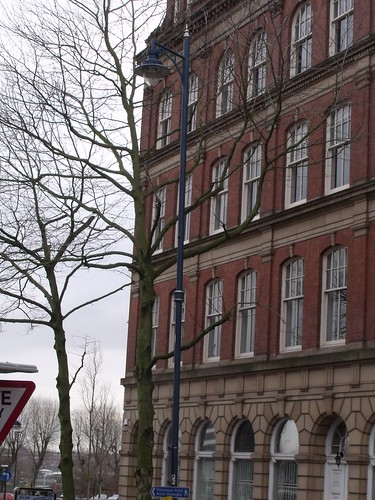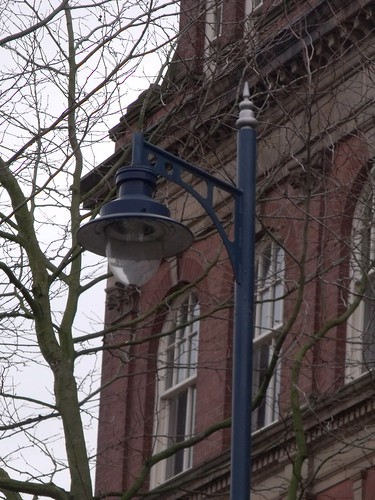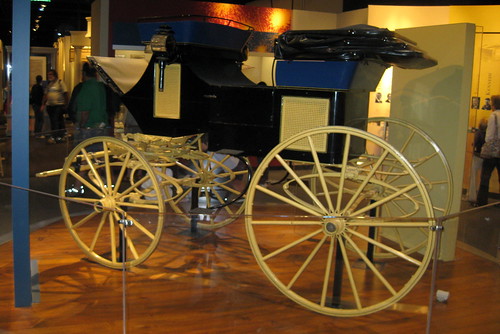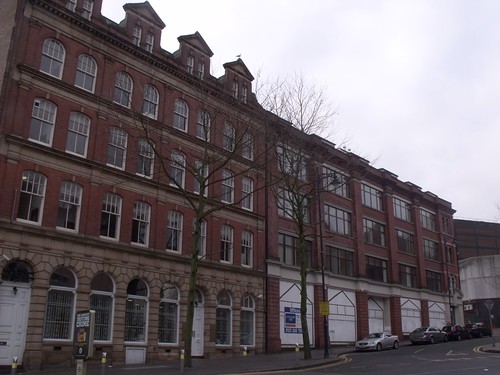Tudor House, Friar St, Worcester - Tudor Rose
Image by ell brown
This is wonderful timbered building on Friar Street in Worcester. Rooms inside are 500 years old.
Tudor House has some Tudor roses on its frontage.
Tudor House
This is the Tudor House Museum, and it is Grade II* listed.
At 38 - 42 Friar Street.
Formerly houses, Cross Keys Tavern from c1765, coffee house c1900-20, now museum. C16, probably c1575-1625. Timber frame with rendered infill; rear wings mostly clad and remodelled in brick in early/mid C18; plain clay tile roofs, 2 large, altered sandstone and brick stacks to rear elevation. PLAN: Front range of 4 bays, sub-divided by party walls which do not respect bay divisions, ground-floor since altered. Outer wings at right angles to main range at rear. C18 carriage-drive inserted to right of centre to access rear. EXTERIOR: 2-storey with attics and cellar. 4 bays of framing, upper floor jettied with mid-rail to close studding; box framing to rest of building. Four first-floor windows, 3 and 4-light mullion and transom leaded-light casements, replacements for earlier oriel windows. C19 shopfront to left ground-floor, two 2/2 sashes to right. North elevation of rear wing to left of passage has arched heads to windows (including early/mid C19 3-light iron casement window in wood frame) and plat bands to first and second-floors; this south wing has exposed timber framing to rear, with central jowled post being all that remains of a C16 workshop range which extended further to rear. INTERIOR: Front range has queen-post roof with clasped purlins and straight wind-braces. 3 open fireplaces with wood bressumers, that to right moulded and probably reset. Ground-floor room to right has mid C18 panelled dado. Ceilings provided to upper floors from outset, with chamfered beam exposed to right; that to left of centre has fine early C17 moulded plaster work, design based on flowing curved ribs enclosing prancing horse, fleur-de-lys and rosette motifs, and central beam with running vine pattern in relief. Mid C18 staircase, quarter-turn with winders and altered with early C20 newel posts, has turned balusters on closed string. Rear wing to north (right) has clasped purlins and queen- post truss, mostly with reused timbers. HISTORICAL NOTE: the rear wings were originally longer and housed loomshops (Hughes). (Buildings of England: Pevsner N: Worcestershire: Harmondsworth: 1968-1985: 334; Worcester Streets: Hughes P and Molyneux N: Friar Street: Worcester: 1984-: 24-27).
Tudor House Museum - Heritage Gateway
Haines House, 28 - 34 Albert Street, Birmingham - blue lamppost outside Haines House
Image by ell brown
I keep spotting this pair of buildings from Moor Street Queensway. Thought they were worth taking.
This is on Albert Street (Saint Michaels Catholic Church is nearby)
28 - 34 Albert Street is the building I usually notice as looking interesting. Best to take it with the Albert Street car park behind you.
It dates from 1888 by Arthur Harrison for William Marston, a carriage lace manufacturer who turned to car trim. A good Queen Anne design in pinky-red brick with a rusticated stone ground floor. This and the segmental windows look almost Neo-Georgian of 1930. Only the dormers and the ground-floor window transoms give the date away.
Above information from Pevsner Architectural Guides: Birmingham by Andy Foster.
Currently, the building is called Haines House. Occupied by Ecotec.
A blue lamppost outside Haines House. It fits the period, even though it is probably modern.
Haines House, 28 - 34 Albert Street, Birmingham - blue lamppost outside Haines House
Image by ell brown
I keep spotting this pair of buildings from Moor Street Queensway. Thought they were worth taking.
This is on Albert Street (Saint Michaels Catholic Church is nearby)
28 - 34 Albert Street is the building I usually notice as looking interesting. Best to take it with the Albert Street car park behind you.
It dates from 1888 by Arthur Harrison for William Marston, a carriage lace manufacturer who turned to car trim. A good Queen Anne design in pinky-red brick with a rusticated stone ground floor. This and the segmental windows look almost Neo-Georgian of 1930. Only the dormers and the ground-floor window transoms give the date away.
Above information from Pevsner Architectural Guides: Birmingham by Andy Foster.
Currently, the building is called Haines House. Occupied by Ecotec.
A blue lamppost outside Haines House. It fits the period, even though it is probably modern.
Washington DC - National Museum of American History: Grant's Carriage
Image by wallyg
Ulysses S. Grant purchased this carriage from Meeks Carriage and Wagon Repository during his first term in the White House and rode in it in his second inauguration in 1873. Meeks brought back the carriage after Grant left office, and it was used in several parades and historic celebrations before being donated to the Smithsonian in 1968.
The American Presidency: A Glorious Burden, an ongoing exhibition, plores the personal, public, ceremonial and executive actions of the 43 men who have had a huge impact on the course of history in the past 200 years. More than 900 objects, including national treasures from the Smithsonian’s vast presidential collections, bring to life the role of the presidency in American culture.
The National Museum of American History (NMAH), administered by the Smithsonian Institute, collects, preserves and displays American heritage in the areas of social, political, cultural, scientific and military history. The museum, which first opened in 1964 as the Museum of History and Technology, is located on the National Mall in one of the last structures designed by McKim, Mead & White. It was renamed in 1980, and closed for a 2-year, million renovation by Skidmore, Owings & Merrill LLP from 2006 to 2008.
The Smithsonian Institution, an educational and research institute and associated museum complex, administered and funded by the government of the United States and by funds from its endowment, contributions, and profits from its shops and its magazines, was established in 1846. Although concentrated in Washington DC, its collection of over 136 million items is spread through 19 museums, a zoo, and nine research centers from New York to Panama.
Haines House, 28 - 34 Albert Street and 20 - 26 Albert Street, Birmingham
Image by ell brown
I keep spotting this pair of buildings from Moor Street Queensway. Thought they were worth taking.
This is on Albert Street (Saint Michaels Catholic Church is nearby)
28 - 34 Albert Street is the building I usually notice as looking interesting. Best to take it with the Albert Street car park behind you.
It dates from 1888 by Arthur Harrison for William Marston, a carriage lace manufacturer who turned to car trim. A good Queen Anne design in pinky-red brick with a rusticated stone ground floor. This and the segmental windows look almost Neo-Georgian of 1930. Only the dormers and the ground-floor window transoms give the date away.
Above information from Pevsner Architectural Guides: Birmingham by Andy Foster.
Currently, the building is called Haines House. Occupied by Ecotec.
To the right is 20 - 26 Albert Street, dating from 1898.
I think that this building is 20 - 26 Albert Street. Dates from 1898, although it looks modernised.
Currently looks like all the units are available to let.
20 - 26 Albert Street of 1898 by J A Chatwin, the entrance with a big broken pediment bitting a two-light window.
From Pevsner Architectural Guides: Birmingham by Andy Foster.
No comments:
Post a Comment